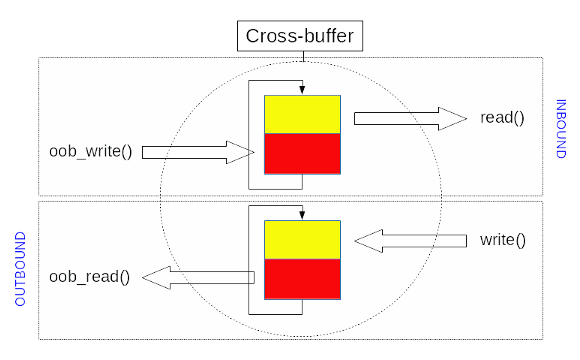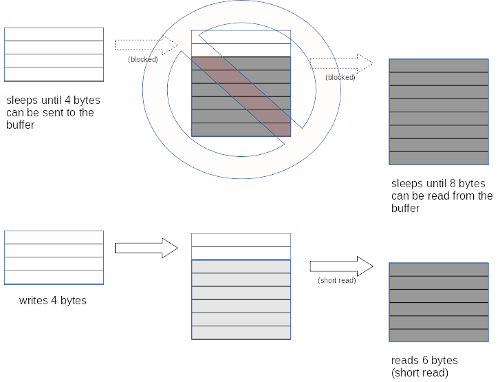Cross-buffer
Bi-directional out-of-band ⇔ in-band messaging
A most typical requirement in dual kernel systems is to exchange data between threads running in separate execution stages, i.e. out-of-band vs in-band, without incuring any delay for the out-of-band side. The EVL core implements a feature called a cross-buffer (aka xbuf), which connects the sending out-of-band end of a communication channel to its receiving in-band end, and conversely. As a result, data sent to a cross-buffer by calling oob_write() are received by calling read(2), data sent by calling write(2) are received by calling oob_read(). A cross-buffer can be used for transferring fixed-size or variable-size data, supports message-based and byte-oriented streams. For instance, such a mechanism would enable a GUI front-end to receive monitoring data from a real-time work loop.
xbuf-specific semantics for sending and receiving
The following rules apply to cross-buffer transfers, in either directions (inbound and outbound):
- If O_NONBLOCK is clear on the cross-buffer file descriptor, there are no short reads on the receiving end: a reader always gets a complete message of the requested length, blocking if necessary except if a sender is currently blocked on the other end of the channel, waiting for some space to be available into the ring buffer to complete a write operation. In this case, a short read is performed to prevent a deadlock, which means the reader may receive fewer data than requested in the read call. This situation arises when the size picked for the ring buffer does not fit the transfer pattern, as illustrated below:
Tip
If you plan to send fixed-size messages through a cross-buffer and keeping the message boundaries intact matters, you should pick a buffer size which is a multiple of the basic message size, reading and writing complete messages at each transfer.
Otherwise, if O_NONBLOCK
is set and not enough bytes are immediately
available from the ring buffer for satisfying the request, the write
operation fails with the EAGAIN error status.
- There are no short or scattered writes to the ring buffer: the
operation either succeeds immediately or blocks until enough space
is available into the buffer for copying the entire message
atomically, unless O_NONBLOCK
is set on the cross-buffer file descriptor (
EAGAIN).
Cross-buffer services
This call creates a new cross-buffer, then returns a file descriptor representing the communication channel upon success. Internally, a cross-buffer is implemented as a pair of ring buffers conveying data from in-band to out-of-band context (i.e. inbound traffic), and conversely (i.e. outbound traffic). oob_write() and oob_read() should be used by callers running on the out-of-band stage for sending/receiving data through this channel respectively. Conversely, write(2) and read(2) should be used for accessing the channel from the in-band stage.
The size in bytes of the ring buffer conveying inbound traffic. If zero, the cross-buffer is intended to relay outbound messages exclusively, i.e. from the in-band to the out-of-band context. i_bufsz must not exceed 2^30.
The size in bytes of the ring buffer conveying outbound traffic. If zero, the cross-buffer is intended to relay inbound messages exclusively, i.e. from the out-of-band to the in-band context. i_bufsz must not exceed 2^30.
A set of creation flags for the new element, defining its visibility:
-
EVL_CLONE_PUBLICdenotes a public element which is represented by a device file in the /dev/evl file hierarchy, which makes it visible to other processes for sharing. -
EVL_CLONE_PRIVATEdenotes an element which is private to the calling process. No device file appears for it in the /dev/evl file hierarchy. -
EVL_CLONE_NONBLOCKsets the file descriptor of the new cross-buffer in non-blocking I/O mode (O_NONBLOCK). By default,O_NONBLOCKis cleared for the file descriptor.
A printf-like format string to generate the cross-buffer name. See this description of the naming convention.
The optional variable argument list completing the format.
evl_create_xbuf() returns the file descriptor of the new cross-buffer on success. If the call fails, a negated error code is returned instead:
-
-EEXIST The generated name is conflicting with an existing cross-buffer name.
-
-EINVAL Either flags is wrong, i_bufsz and/or o_bufsz are wrong, or the generated name is badly formed.
-
-ENAMETOOLONG The overall length of the device element’s file path including the generated name exceeds PATH_MAX.
-
-EMFILE The per-process limit on the number of open file descriptors has been reached.
-
-ENFILE The system-wide limit on the total number of open files has been reached.
-
-ENOMEM No memory available.
-
-ENXIO The EVL library is not initialized for the current process. Such initialization happens implicitly when evl_attach_self() is called by any thread of your process, or by explicitly calling evl_init(). You have to bootstrap the library services in a way or another before creating a cross-buffer.
This call is a shorthand for creating a private cross-buffer with identically-sized I/O buffers. It is identical to calling:
evl_create_xbuf(io_bufsz, io_bufsz, EVL_CLONE_PRIVATE, fmt, ...);Info
Note that if the generated name starts with a
slash (’/’) character, EVL_CLONE_PRIVATE would be automatically turned
into EVL_CLONE_PUBLIC internally.
Events pollable from a cross-buffer descriptor
The evl_poll() interface can monitor the following events occurring on a cross-buffer file descriptor:
-
POLLIN and POLLRDNORM are set whenever data coming from the in-band side is available for reading by a call to oob_read().
-
POLLOUT and POLLWRNORM are set whenever there is still room in the output ring buffer for sending more data to the in-band side using oob_write().
Conversely, you can also use the in-band poll(2) on a cross-buffer file descriptor, monitoring the following events:
-
POLLIN and POLLRDNORM are set whenever data coming from the out-of-band side is available for reading, by a call to read(2).
-
POLLOUT and POLLWRNORM are set whenever there is still room in the output ring buffer for sending more data to the out-of-band side, using write(2).


